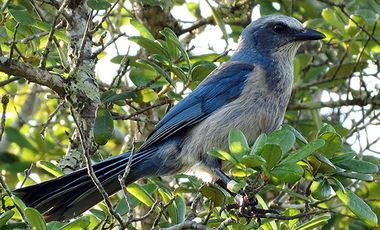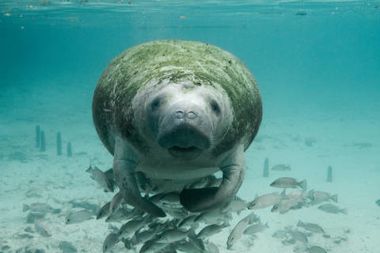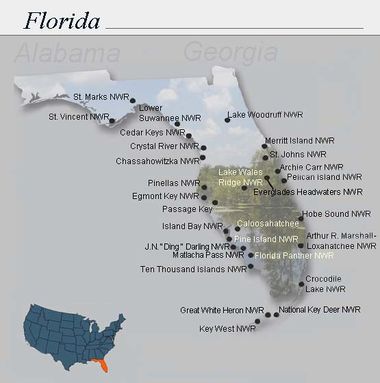United States Fish and Wildlife Service Southeast Region
The U.S. Fish and Wildlife Service's (FWC) Southeast Region 4 carries out the FWS mission within the states of Alabama, Arkansas, Florida, Georgia, Kentucky, Louisiana, Mississippi, North Carolina, South Carolina and Tennessee, as well as Puerto Rico and the U.S. Virgin Islands. The regional office is located in Atlanta, Georgia.[1]
Southeast Region Functions
- Protecting and recovering hundreds of southeastern species protected as threatened or endangered under the Endangered Species Act,
- Gathering the best available scientific and commercial data for protected species to perform recovery actions,
- Preserving healthy habitats for wildlife and opportunities for public recreation at 131 National Wildlife Refuges,
- Investigating wildlife crimes such as wildlife trafficking and the illegal shooting of protected species,
- Producing fish for stocking across southeastern rivers,
- Conducting research on the health of southeastern habitats,
- Permitting certain public and private development activities to ensure they do not jeopardize the continued existence of endangered species,
- Proactively pursuing opportunities to conserve species at-risk of becoming listed as threatened or endangered,
- Working with private landowners to restore, improve and protect fish and wildlife habitat on their lands,
- Distributing over $250 million annually in grants to state conservation agencies, and
- Communicating and educating the American public about wildlife conservation via social media, educational programs, public hearings, and other forms of outreach.
FWS Florida Field Offices
U.S. Fish and Wildlife Service Offices governing the Indian River Lagoon National Estuary:[2]
South Florida Ecological Services Field Office, Vero Beach, Florida: The Ecological Services Division of the USFWS works to protect and restore healthy populations of fish and wildlife and the environments on which they depend. To accomplish this, the South Florida Ecological Services Field Office has these programs: Everglades Restoration, Coastal Ecology, Contaminants, Endangered Species, Habitat Conservation, and Partners for Fish and Wildlife.
Florida Migratory Bird Field Office, Havana, Florida: Established in Spring 2009 and providing biological review and assistance on wildlife habitat and population management within Florida and the Caribbean Islands, with emphasis on trust/migratory bird species. Florida FWS Migratory Bird Field Office provides technical support and consultation to 28 National Wildlife Refuges (NWRs) in Florida, five NWRs in Puerto Rico, and three NWRs in the Virgin Islands to fulfill the purposes for which these refuges were established.
FWS IRL Property
These FWS properties are in or near the Indian River Lagoon Estuary:[2]
Merritt Island National Wildlife Refuge: The refuge traces its beginnings to the development of the nation’s Space Program. In 1962, NASA acquired 140,000 acres of land, water, and marshes adjacent to Cape Canaveral to establish the John F. Kennedy Space Center. NASA built a launch complex and other space-related facilities, but development of most of the area was not necessary. In1963 the U.S. Fish and Wildlife Service signed an agreement to establish the refuge and in 1975 a second agreement established Canaveral National Seashore. Today, the Department of Interior manages most of the unused portions of the Kennedy Space Center as a National Wildlife Refuge and National Seashore. Merritt Island NWR Contact Info
St. Johns NWR: The St. Johns National Wildlife Refuge was established in 1971 to protect threatened and endangered species and to specifically provide adequate habitat to recover the dusky seaside sparrow from extinction. In December 1990, the species was declared extinct and the critical habitat of St. Johns NWR was delisted. Despite the loss of the dusky seaside sparrow, at least 19 federal and state listed species are known to occur today at St. Johns NWR. St. Johns NWR Contact Info
Archie Carr NWR: The Archie Carr National Wildlife Refuge stretches across 20.5 miles between Melbourne Beach and Wabasso Beach along Florida's east coast in Brevard and Indian River Counties. The refuge was established in 1991 and was named after the late Dr. Archie Carr, Jr., in honor of his extraordinary contribution to sea turtle conservation. The Refuge is a direct result of Dr. Carr bringing attention to the world's declining turtle populations due to over-exploitation and loss of safe habitat. Archie Carr NWR Contact Info
Pelican Island NWR: With a history that symbolizes our nation’s dedication to her cherished lands, the Refuge holds the distinction of being our nation’s first national wildlife Refuge. The Refuge has provided a natural home for fish and wildlife, while proudly serving as the ambassador for the development of the National Wildlife Refuge System. Through the creation of 563 refuges throughout the nation since its designation in 1903, Pelican Island National Wildlife Refuge has stood as a testament to our nation’s commitment to the conservation of natural lands. Pelican Island NWR Contact Info
Hobe Sound NWR: Nathaniel P. Reed Hobe Sound National Wildlife Refuge is one of over 565 refuges in the National Wildlife Refuge System - a network of lands set aside and managed by the U.S. Fish and Wildlife Service specifically for wildlife. The area consists of 1,091 acres, bisected by the Indian River Lagoon into two tracts: the Jupiter Island tract and the mainland tract. On Jupiter Island, the Refuge contains the largest contiguous section of undeveloped beach in Southeastern Florida and is considered one of the most productive sea turtle nesting areas in the Southeastern United States. Hobe Sound NWR Contact Info
Everglades Headwaters National Wildlife Refuge and Conservation Area: The U.S. Fish and Wildlife Service is working to conserve the natural resources and rural way of life in the Kissimmee River Valley. If fully realized, the refuge and conservation area will span 150,000 acres north of Lake Okeechobee. Two-thirds of the acreage, or 100,000 acres, will be protected through conservation easements purchased from willing sellers. With easements, private landowners would retain ownership of their land, as well as the right to work the land to raise cattle or crops. The easements would ensure the land could not be developed. Everglades Headwaters NWR And Conservation Area Contact Info



